Where Art in Interior Design Begins: Local Connections
Last week, I joined a lively crew on Boston’s South Shore to talk about fine art in interior design. The South Shore Art Center hosted the panel, led by Executive Director Patrice Maye, following a striking new installation featuring two local artists: Alyssa Fortin and Curtis Speer. I joined the conversation alongside Kelly Netishen and Christina Godfrey—two powerhouse women who know their way around a gallery wall.
The South Shore Art Center has been holding it down in Cohasset since 1955. A nonprofit that brings art, education, and exhibitions to over 20,000 visitors each year, all under the leadership of Patrice —an arts advocate with a big heart for community. She’s helped bring in new youth programs, boundary-pushing exhibitions, and fresh energy across the board. Patrice brings warmth, sharp instincts, and real follow-through—and she’s funny and can hold a room.
Let’s start with a few words about the current exhibit and the artists on view—then I’ll introduce the other panelists and share highlights from our conversation.
Capturing Renewal in Motion: Alyssa Fortin’s Ballet Series
Alyssa is a Massachusetts-based fine art photographer, best known for her underwater ballet series. Her work captures dancers suspended in water, wrapped in fabric and soft light, exploring themes of transformation and rebirth. In her “Temps de Poisson” series, ballerinas appear in fluid, dreamlike poses. Inspired by sea life—like the movement of jellyfish and fish fins—her images feel weightless and surreal. You don’t just look at them—you float with them.
During the panel, a woman in the audience shared that she had purchased one of Alyssa’s first underwater photographs. She described how the image captured what it felt like to be an entrepreneur—like falling, but with intention. Her simple comment that reframed how I viewed the collection, and reminded me how powerful it is to hear how others experience art. And, as a ‘solopreneur’… I relate! the questions creep in—Is this working? Am I on the right path? Should I go back and work for someone else? That floating, falling feeling hits close to home.
My take: I’m no ballerina, but I was a gymnast. I understand the movement—and I’ve logged plenty of hours in barre class. I always wished I’d studied ballet, I’m drawn the the ‘graceful, but strong’ aspect. And that’s what I saw in Alyssa’s work: feminine, delicate—but never weak. Strength wrapped in softness. For interiors, I can see these pieces in a bath, or a bedroom, dressing room or a walk in closet. Any space worth of strong feminine energy.
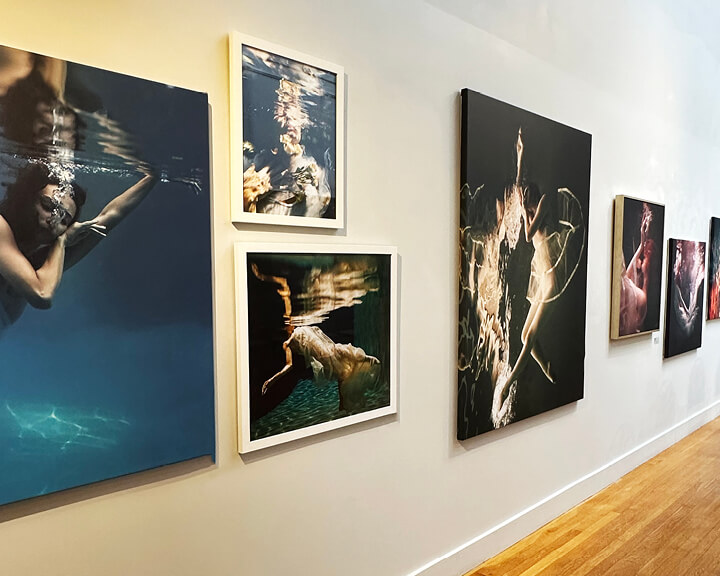
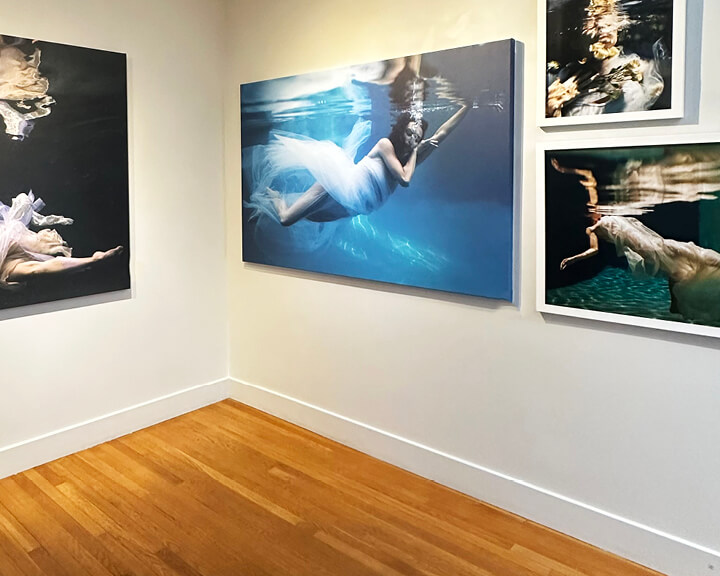

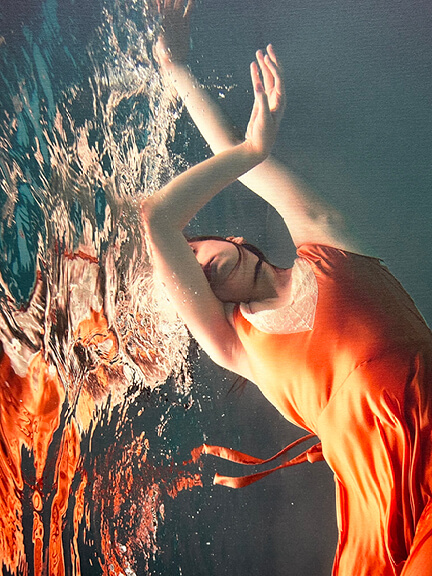

Curtis Speer
Curtis Speer, photographer and owner of CUSP Gallery, brought a whole different energy. He opened CUSP in Newport in 2023 and now runs it out of a historic 1801 building—think original floors and dimly lit, moody walls (you know I love a historic home). He offers water, snacks, or even prosecco when you arrive—and since he lives upstairs, visiting the gallery feels like being welcomed into his home. You’re treated like a guest, not just a visitor.
Curtis’s work is very cool. At first glance, they look like paintings—but they’re actually photograph printed on a unique substrate: heavyweight cotton rag paper. Some pieces are actually printed on aluminum to withstand the salt air—yes, they can even be hung outdoors or on yachts.
His still lifes feature vintage objects (which I always love), and organic elements like produce and flowers. I’m drawn to anything that feels fresh—even when set against a black background, which makes the subjects stand out even more. But what really got me was hearing Curtis talk about the meaning behind each piece; like Alyssa, his work also explores themes of rebirth and renewal. So while his visuals are quite different from Fortin’s, their underlying motivations feel aligned.For interiors, I could easily picture these still lifes in a powder room or kitchen—they’re intimate, timeless, and unexpectedly powerful.
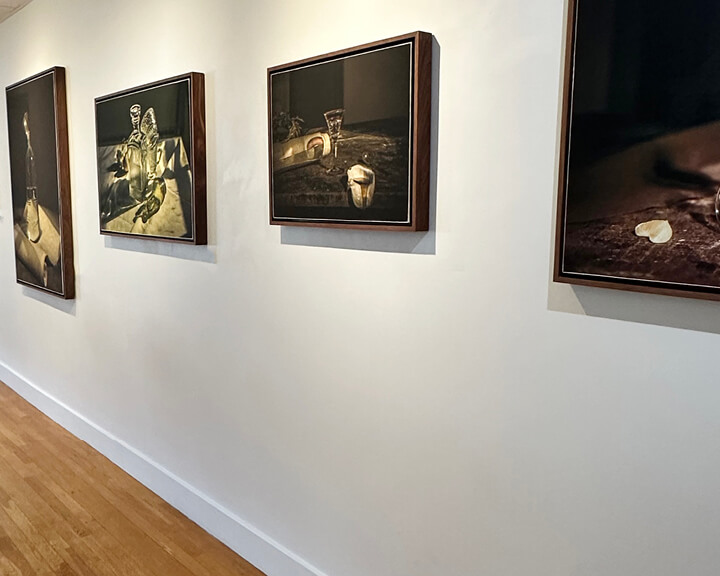
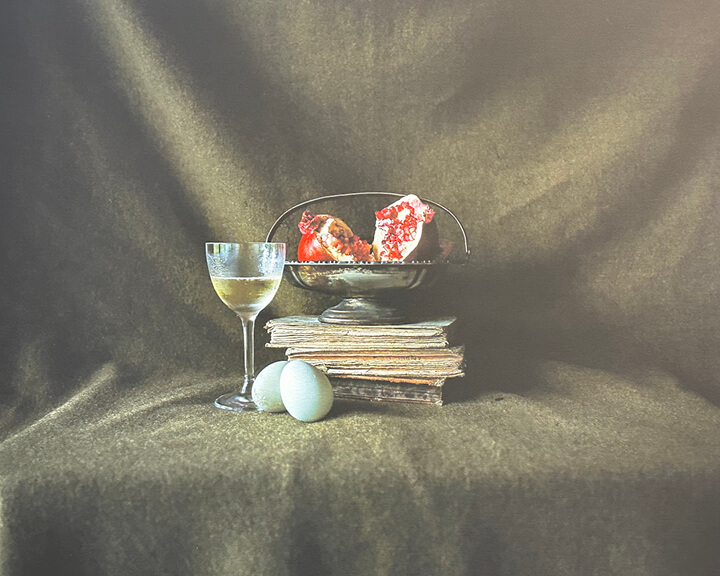
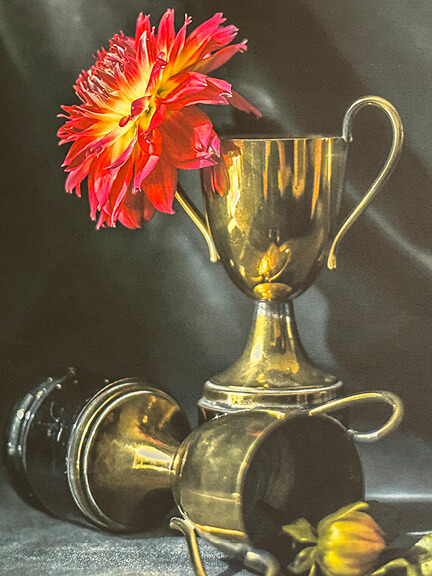
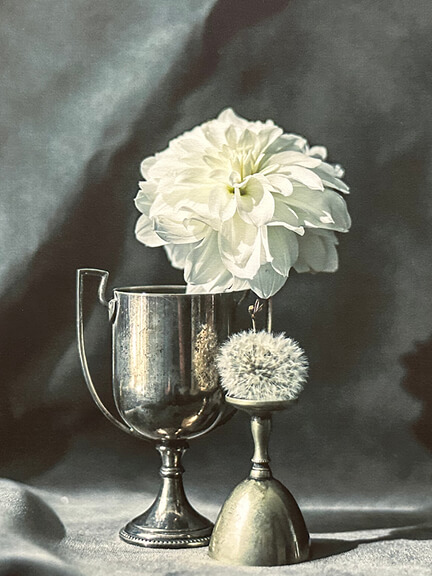
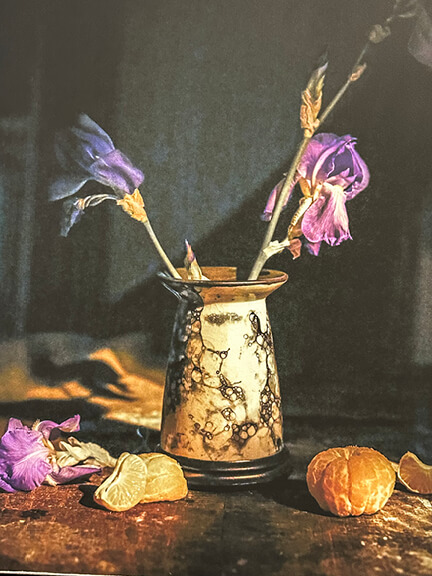
Kelly Netishen
Kelly Netishen wears many hats—interior stylist, art consultant, and co-founder of Art Girls in Minneapolis. Her work helps people collect and live with art, minus the pressure or intimidation. She’s big on “test-driving” pieces and shaping collections over time. Kelly is also a longtime board member at SSAC and a hands-on curator with a sharp eye. On our panel, she brought the practical side of collecting—how to hang, group, light, and live with art, even when you’re working around pets, kids, and more.
Christina Godfrey | Savage Godfrey Gallery
Christina Godfrey runs Savage Godfrey Gallery in Norwell—formerly known as Sunne Savage Gallery, founded by her mother in 1975. She joined the family business in 2001 and has since modernized their focus, balancing corporate art services with bold, rotating exhibitions. Her shows spotlight regional talent and keep things moving with fresh work every 8–12 weeks. She also offers framing, conservation, appraisals, and commissions. Christina brought great insights on curating spaces that mix tradition and edge—Plus, her father was a well-known artist, and she often speaks fondly of her art-filled childhood—witnessing firsthand how meaningful pieces can create a lasting legacy within a family.
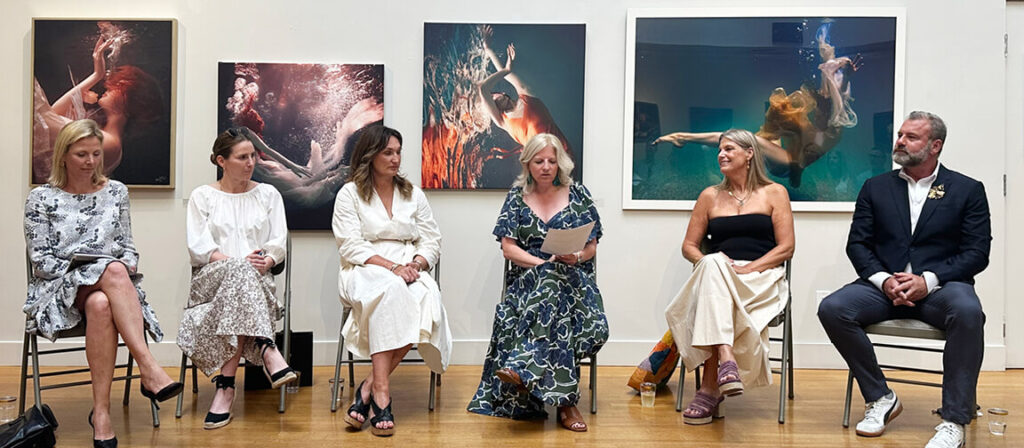
The Panel Talk: Where Art Meets Interior Design
Our panel focused on one central question: How do art and design intersect in meaningful ways? While art should never be an afterthought—or just a line item in a budget—it often gets overlooked in the design process. Each panelist brought a different perspective on how homeowners, designers, gallery owners, and collectors can make room for something personal and powerful. As the designer on the panel, I shared how I tackle this in my own work:
Dont’ Forget the Art
1. Keep a line item in the budget. Art deserves its own allocation—not just leftovers. It’s tough to make space for fine art after a long renovation or while furnishing an entire house. But blank walls are scary. Talk about art early and consistently—and keep it in the budget from the start.
2. Draw it into the plans. I include artwork in floor plans and elevations. It’s part of the architecture. Whether it’s a large piece, a small grouping, or a sculpture—I include it in my drawings. The client and team know about the art wall from the very beginning, so the space is planned and ready when it’s time to make the purchase.
3. Plan for lighting. Bad lighting can ruin great art. Include art lighting in your reflected ceiling plan (RCP)—whether that’s wall washers, art lamps, or spotlights. Design tip: Decide on the artwork’s scale first, then light it properly. Both matter.
4. Stay in touch with local artists and galleries. Relationships matter. Often, I borrow art frrom galleries or artists to help clients visualize how it feels in a space in real time. A great gallery—or a welcoming artist—will often let you borrow the work, which sometimes ‘sells‘ the piece.
5. Follow emerging artists. Buying early is affordable and adds meaning. Emerging artists are working to get their name out there, and early pieces are often more accessible. Stay in the loop—you could be one of the first to spot a future big name.
Designing Interiors Around Fine Art
Some of my favorite spaces in my portfolio celebrate fine art—from a range of aesthetics, styles, mediums, and values. Every client approaches art differently, but when they’re open to my suggestions—or bring their own beautiful pieces to the table—the rooms are always stronger for it.
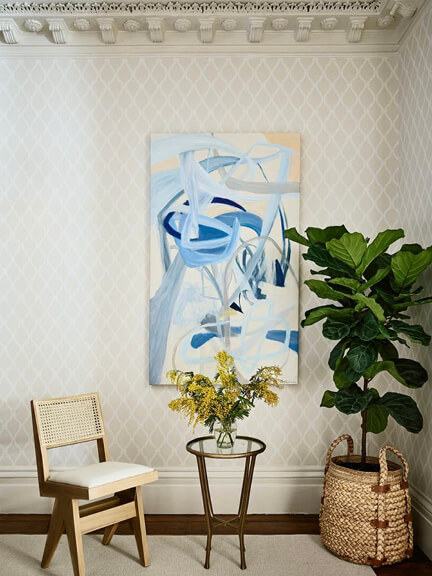
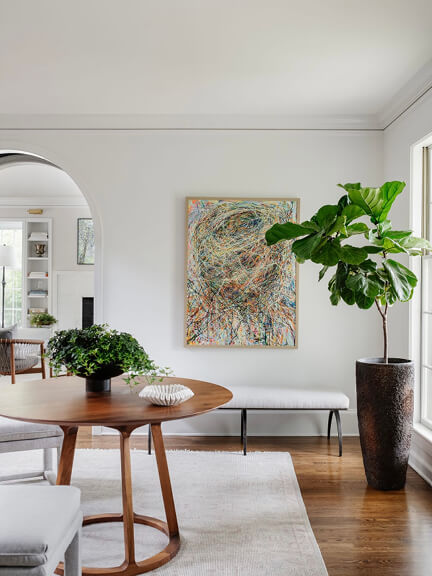
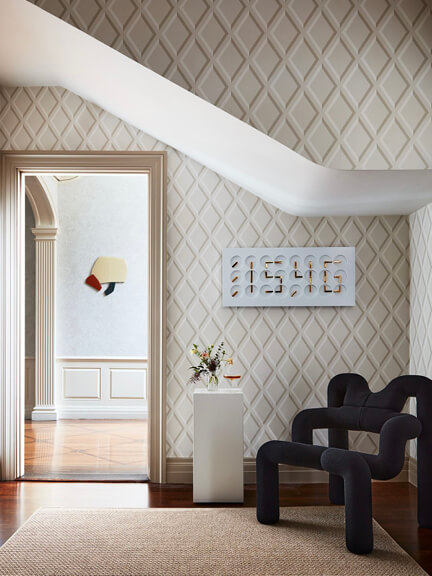
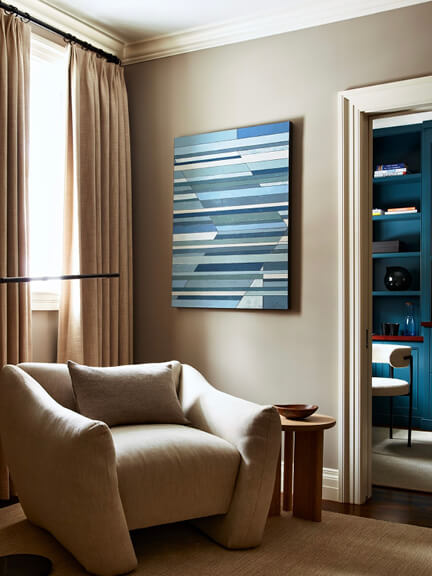

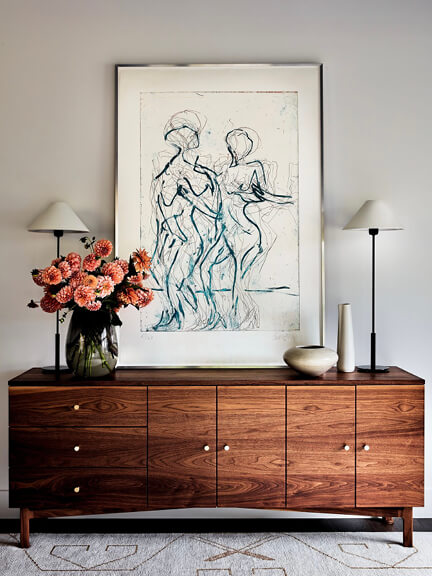
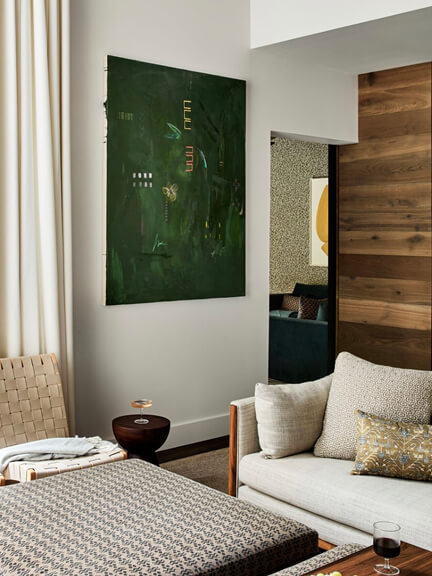

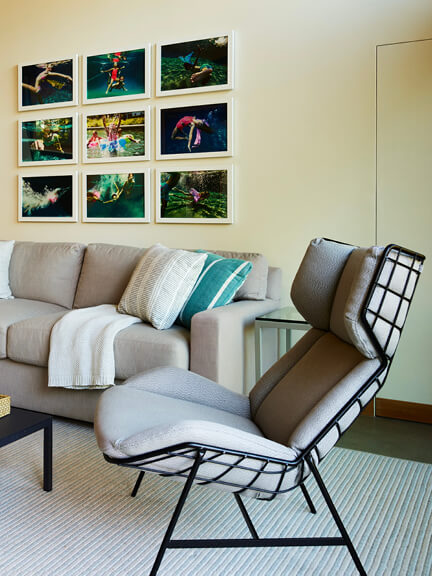
Uncopyable Interior Design
Blank walls are intimidating. But comfortable homes—great homes—include more than beautiful architecture and furniture. They include art. We love layered and dynamic collections: paintings, drawings, photography, and prints. Mix them, make it personal; choose pieces that reflect your travels, your worldview, or a family moment. But please, please, don’t buy your art at HomeGoods.
Our best advice? Be uncopyable. No one wants the same living room as their neighbor. Support local artists, visit real galleries, and bring home pieces that make your space feel personal—mixing styles, mediums, and stories in a way that’s truly one of a kind.
And if you’re unsure about scale, color theory, or proportion—get a designer. That’s what we’re here for. See more about how we find inspiration—from travel to museum visits—and read how we approach decorating, turning houses into layered, personal homes.